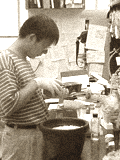Phaeohyphomycosis:
PHAEOHYPHOMYCOSIS (PHM)1
PHM is an infection of
humans and other animals caused by a number of phaeoid
(melanized) fungi, characterized by the development of
dark-colored hyphae and other types of fungal
elements, depending on species, in invaded tissues.
The term PHM encompasses distinct mycotic infections
regardless of the site of the lesion, the pattern of
tissue response, granuloma or abscess, or the
taxonomic classification of the etiologic agents.
With the increasing
number of immunocompromised patients, the number of
genera and species of fungi causing PHM has been
growing. As of 1998, the phaeoid fungi, verified as
causing PHM, comprised 109 species classified in 60
genera. Certainly, this number has increased over the
past decade. The most common etiologic agents are
Exophiala jeanselmei and
Wangiella (Exophiala)
dermatitidis, followed by such phaeoid fungus
species as Alternaria alternata, Bipolaris
spicifera, Curvularia lunata,
Exophiala
moniliae, E.
spinifera, Exserohilum rostratum, Phaeoacremonium
parasiticum, Phialemonium obovatum, and
Phialophora repens. Deep-seated cases of PHM have
been caused by more than 40 species classified in at
least 27 genera. In particular, 44% of cerebral PHM
infections are caused by Cladophialophora bantiana.
Clinical and Pathologic Manifestations:
PHM is a cosmopolitan
disease. Patients are usually adults, and about half
of them seem to be immunologically compromised by
associated underlying diseases such as diabetes
mellitus, tuberculosis, leprosy, acquired
immunodeficiency syndrome (AIDS), lymphoma, and
leukemia. Some patients appear to be locally
compromised because of the application of topical
corticosteroids. PHM lesions may occur anywhere in the
body, often in exposed parts, especially the upper
arms. Frequently, but not exclusively, inoculation of
the agent is by wounds made by contaminated materials.
The most common and
typical lesions are cutaneous or subcutaneous cysts or
abscesses, frequently caused by E. jeanselmei.
The primary lesion occurs as a single, discrete,
asymptomatic small nodule. This is palpable under the
smooth and slightly elevated skin. The nodule
gradually evolves to become an encapsulated, fluctuant
abscess with a liquefied center. The overlying
epidermis is hardly affected, and formation of a sinus
tract or ulceration is rarely observed. Occasionally,
a granulomatous, slightly elevated plaque may appear
when the main site of the lesion is in the epidermis
and dermis. Less frequently, it is manifested as a
small verrucous nodule or plaque consisting of
coalesced nodules, which resembles the clinical
appearance of CBM.
Lymph node involvement
and dissemination are rare. However, PHM may occur in
the central nervous system or other internal organs,
such as the liver, lungs, or pancreas. It may appear
as a hematogenous metastasis from cutaneous or
subcutaneous infections, or without any visible
lesions. Human infections caused by W. dermatitidis
have been equally distributed between cutaneous and
subcutaneous infections, and systemic involvement.
Wangiella
dermatitidis should be regarded as a dermotropic
and neurotropic pathogen.
Because of this, its designation as a paradigm for
phaeohyphomycosis is appropriate.
Cyst or abscess
formation is mainly confined to the dermis and
adjacent subcutaneous tissue. Three stages have been
described: (1) a tuberculoid phase, (2) a stellate
abscess, and (3) a fluctuant abscess. In the primary
lesion, a hypercellular tubercle composed mainly of
epithelioid cells and foreign body giant cells is
formed. Scattered foci of necrosis follow, accompanied
by acute and chronic cellular infiltrations, and
stellate abscesses develop. The stellate abscesses
coalesce to transform themselves into a fluctuant
abscess.
A thick wall surrounds
the abscess. The inner layer is made up of a
combination of epithelioid cells, macrophages, giant
cells of foreign body and Langhans' types, and
neutrophils. The middle layer is composed
predominantly of vascularized scar tissue surrounded
by an outer layer of hyaline fibrous tissue. The
center of the abscess contains necrotic debris mixed
with polymorphonuclear leukocytes. Foreign plant
material, as in CBM, may be present. The granulomatous
lesions in the middle to upper dermis mainly consist
of epithelioid cells and giant cells that are covered
by the necrotic epidermis. Pseudoepitheliomatous
hyperplasia, hyperkeratosis, parakeratosis, and
acanthosis overlying the upper dermal granuloma are
recognized in PHM. These appear clinically as
verrucous plaques resembling CBM.
Treatment and Prognosis:
Successful treatment of
cutaneous and subcutaneous PHM is achieved by simple
surgical excision. However, cases of systemic and
disseminated PHM are serious and have a high mortality
rate. Antifungal chemotherapy is not easy because of
the huge variety of etiologic agents. Amphotericin B
or flucytosine or combination therapy with these
agents, and treatment with fluconazole, itraconazole,
ketoconazole, or terbinafine has been reported with
mixed results. clinical responses are well correlated
with in vitro susceptibility test results; however,
resistance does not preclude clinical response.
As in cases of CBM, new
antifungal agents may prove important in the treatment
of PHM. Most fungi causing PHM are sensitive in
vitro to the triazole, voriconazole, as well as
itraconazole, an imidazole antifungal agent. Many
agents of PHM that cause superficial infections are
susceptible to terbinafine in addition to the
echinocandins. In contrast, the pathogenic agents of
PHM appear less sensitive to fluconazole in vitro.
Local heat therapy,
using a pocket warmer or an electric pad, may also be
applied to cutaneous and subcutaneous PHM, even though
some of the etiologic fungi possess considerable
thermotolerance.
Prevention and Control:
Prevention and control are not practical for PHM.
Owing to the cosmopolitan, ubiquitous nature of the
fungi causing PHM, it is not feasible to attempt their
eradication.
1.Matsumoto,
T., C. R. Cooper, Jr. and P. J. Szaniszlo.
Chromoblastomycosis and Phaeohyphomycosis.
p.569-572.. In: R. L. Guerrant, D. H. Walker and P.
F. Weller (ed.) Infectious Diseases: Principles,
Pathogens, and Practice, Third Edition, (2011).
Saunders Elsevier, Oxford, U.K.
|
 |